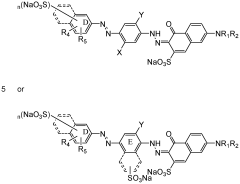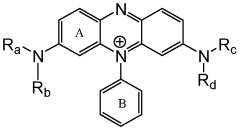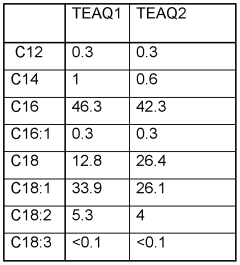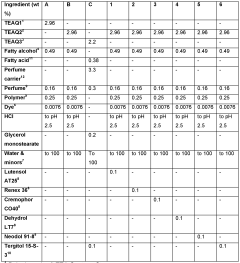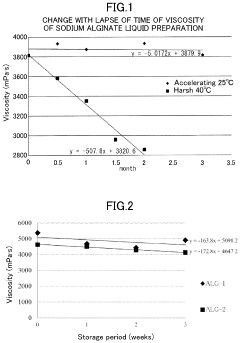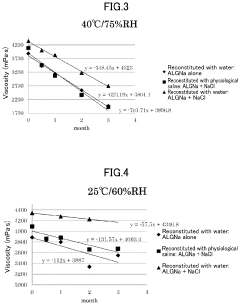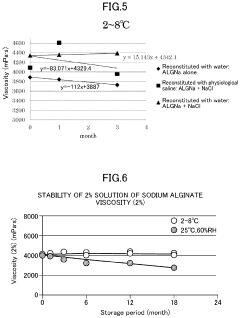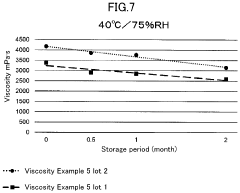How to Increase Viscosity for Textiles Using Sodium Alginate?
JUL 14, 20259 MIN READ
Generate Your Research Report Instantly with AI Agent
Patsnap Eureka helps you evaluate technical feasibility & market potential.
Sodium Alginate Textile Thickening Background
Sodium alginate, a natural polysaccharide derived from brown seaweed, has been utilized in the textile industry for decades as a thickening agent. Its unique properties make it an ideal candidate for increasing the viscosity of textile printing pastes and dyes. The use of sodium alginate in textile processing can be traced back to the mid-20th century when the demand for more efficient and environmentally friendly thickeners began to rise.
The textile industry has long sought effective methods to control the viscosity of printing pastes and dyes to achieve optimal print quality and color fastness. Traditional thickeners often presented challenges such as inconsistent performance, poor stability, and environmental concerns. The introduction of sodium alginate as a thickening agent marked a significant advancement in addressing these issues.
Sodium alginate's ability to form stable, high-viscosity solutions in water at relatively low concentrations made it an attractive option for textile manufacturers. Its non-toxic nature and biodegradability aligned well with the growing environmental consciousness in the industry. Furthermore, its compatibility with various dyes and pigments, coupled with its ability to produce clear, colorless solutions, made it suitable for a wide range of textile applications.
The evolution of sodium alginate use in textiles has been driven by continuous research and development efforts. Early applications focused primarily on its thickening properties for screen printing. However, as understanding of its chemical structure and behavior deepened, new applications emerged. These included its use in digital printing, as a binder in pigment printing, and even in functional finishes for textiles.
The textile industry's adoption of sodium alginate as a thickener was further propelled by advancements in alginate production techniques. Improved extraction and purification methods led to more consistent and higher quality sodium alginate products, enhancing its reliability in textile processing. This, in turn, encouraged wider adoption across various textile sectors, from apparel to home furnishings and technical textiles.
As the textile industry continues to evolve, with increasing emphasis on sustainability and performance, the role of sodium alginate in viscosity control remains significant. Current research focuses on optimizing its use in combination with other additives, exploring novel modification techniques to enhance its properties, and developing new applications that leverage its unique characteristics.
The textile industry has long sought effective methods to control the viscosity of printing pastes and dyes to achieve optimal print quality and color fastness. Traditional thickeners often presented challenges such as inconsistent performance, poor stability, and environmental concerns. The introduction of sodium alginate as a thickening agent marked a significant advancement in addressing these issues.
Sodium alginate's ability to form stable, high-viscosity solutions in water at relatively low concentrations made it an attractive option for textile manufacturers. Its non-toxic nature and biodegradability aligned well with the growing environmental consciousness in the industry. Furthermore, its compatibility with various dyes and pigments, coupled with its ability to produce clear, colorless solutions, made it suitable for a wide range of textile applications.
The evolution of sodium alginate use in textiles has been driven by continuous research and development efforts. Early applications focused primarily on its thickening properties for screen printing. However, as understanding of its chemical structure and behavior deepened, new applications emerged. These included its use in digital printing, as a binder in pigment printing, and even in functional finishes for textiles.
The textile industry's adoption of sodium alginate as a thickener was further propelled by advancements in alginate production techniques. Improved extraction and purification methods led to more consistent and higher quality sodium alginate products, enhancing its reliability in textile processing. This, in turn, encouraged wider adoption across various textile sectors, from apparel to home furnishings and technical textiles.
As the textile industry continues to evolve, with increasing emphasis on sustainability and performance, the role of sodium alginate in viscosity control remains significant. Current research focuses on optimizing its use in combination with other additives, exploring novel modification techniques to enhance its properties, and developing new applications that leverage its unique characteristics.
Market Demand Analysis
The market demand for sodium alginate as a viscosity enhancer in textiles has been steadily growing due to its unique properties and versatile applications. This natural polysaccharide, derived from brown seaweed, offers excellent thickening, stabilizing, and film-forming capabilities, making it highly sought after in the textile industry.
The global textile market has been experiencing a shift towards sustainable and eco-friendly materials, driving the demand for natural additives like sodium alginate. As consumers become more environmentally conscious, there is an increasing preference for textiles produced using renewable resources and biodegradable components. Sodium alginate aligns perfectly with this trend, being a bio-based and biodegradable material.
In the textile printing sector, sodium alginate plays a crucial role as a thickening agent for dyes and pigments. Its ability to increase viscosity without affecting color intensity or fabric properties has made it an essential component in textile printing pastes. The growing demand for high-quality, vibrant, and long-lasting printed textiles has further boosted the market for sodium alginate in this application.
The technical textile segment has also shown significant interest in sodium alginate-based solutions. Its film-forming properties make it valuable in creating functional coatings for textiles, enhancing water resistance, breathability, and durability. This has led to increased adoption in industries such as sportswear, outdoor gear, and protective clothing.
Geographically, Asia-Pacific dominates the market for sodium alginate in textiles, with China and India being the major consumers. The robust textile manufacturing sectors in these countries, coupled with increasing domestic demand for high-quality textiles, have been driving the growth. Europe and North America follow, with a focus on technical textiles and sustainable fashion driving demand in these regions.
The market for sodium alginate in textiles is expected to continue its growth trajectory, fueled by innovations in application techniques and the development of new textile products. As research progresses, new opportunities are emerging in areas such as smart textiles and medical textiles, where sodium alginate's biocompatibility and unique properties can be leveraged to create advanced functional fabrics.
However, challenges such as fluctuating raw material prices and competition from synthetic thickeners may impact market growth. Despite these challenges, the overall outlook remains positive, with the textile industry's ongoing shift towards sustainable solutions expected to sustain the demand for sodium alginate as a viscosity enhancer in the coming years.
The global textile market has been experiencing a shift towards sustainable and eco-friendly materials, driving the demand for natural additives like sodium alginate. As consumers become more environmentally conscious, there is an increasing preference for textiles produced using renewable resources and biodegradable components. Sodium alginate aligns perfectly with this trend, being a bio-based and biodegradable material.
In the textile printing sector, sodium alginate plays a crucial role as a thickening agent for dyes and pigments. Its ability to increase viscosity without affecting color intensity or fabric properties has made it an essential component in textile printing pastes. The growing demand for high-quality, vibrant, and long-lasting printed textiles has further boosted the market for sodium alginate in this application.
The technical textile segment has also shown significant interest in sodium alginate-based solutions. Its film-forming properties make it valuable in creating functional coatings for textiles, enhancing water resistance, breathability, and durability. This has led to increased adoption in industries such as sportswear, outdoor gear, and protective clothing.
Geographically, Asia-Pacific dominates the market for sodium alginate in textiles, with China and India being the major consumers. The robust textile manufacturing sectors in these countries, coupled with increasing domestic demand for high-quality textiles, have been driving the growth. Europe and North America follow, with a focus on technical textiles and sustainable fashion driving demand in these regions.
The market for sodium alginate in textiles is expected to continue its growth trajectory, fueled by innovations in application techniques and the development of new textile products. As research progresses, new opportunities are emerging in areas such as smart textiles and medical textiles, where sodium alginate's biocompatibility and unique properties can be leveraged to create advanced functional fabrics.
However, challenges such as fluctuating raw material prices and competition from synthetic thickeners may impact market growth. Despite these challenges, the overall outlook remains positive, with the textile industry's ongoing shift towards sustainable solutions expected to sustain the demand for sodium alginate as a viscosity enhancer in the coming years.
Current Challenges in Textile Viscosity Enhancement
The textile industry faces several significant challenges in enhancing viscosity using sodium alginate. One of the primary issues is achieving consistent viscosity across different batches of textiles. Sodium alginate's thickening properties can vary depending on factors such as temperature, pH, and the presence of other chemicals in the textile processing environment. This variability makes it difficult to maintain uniform viscosity levels, which is crucial for ensuring consistent quality in textile production.
Another challenge lies in the balance between viscosity and other desirable textile properties. While increased viscosity can improve certain aspects of textile performance, such as dye retention and fabric stability, it may also negatively impact other characteristics like fabric softness and drapeability. Finding the optimal viscosity level that enhances desired properties without compromising others remains a complex task for textile manufacturers.
The interaction between sodium alginate and different fiber types presents an additional hurdle. Natural fibers like cotton may respond differently to sodium alginate treatments compared to synthetic fibers like polyester. This diversity in fiber reactions necessitates the development of tailored viscosity enhancement approaches for various textile compositions, adding complexity to the manufacturing process.
Environmental concerns also pose challenges in viscosity enhancement using sodium alginate. As the textile industry faces increasing pressure to adopt more sustainable practices, there is a growing need to ensure that viscosity enhancement methods are environmentally friendly. This includes considerations such as biodegradability of the thickening agents and the reduction of water consumption in the treatment process.
Furthermore, the cost-effectiveness of using sodium alginate for viscosity enhancement is a significant concern for many textile manufacturers. While sodium alginate is a versatile and effective thickening agent, its cost can be higher compared to some synthetic alternatives. Balancing the benefits of improved viscosity with the economic constraints of production remains a challenge, particularly for manufacturers operating in competitive markets with tight profit margins.
Lastly, the scalability of sodium alginate-based viscosity enhancement techniques presents challenges in large-scale textile production. Ensuring uniform application and consistent results across large batches of textiles requires sophisticated process control and monitoring systems. Developing and implementing such systems that can effectively manage viscosity enhancement at an industrial scale is an ongoing challenge for the textile industry.
Another challenge lies in the balance between viscosity and other desirable textile properties. While increased viscosity can improve certain aspects of textile performance, such as dye retention and fabric stability, it may also negatively impact other characteristics like fabric softness and drapeability. Finding the optimal viscosity level that enhances desired properties without compromising others remains a complex task for textile manufacturers.
The interaction between sodium alginate and different fiber types presents an additional hurdle. Natural fibers like cotton may respond differently to sodium alginate treatments compared to synthetic fibers like polyester. This diversity in fiber reactions necessitates the development of tailored viscosity enhancement approaches for various textile compositions, adding complexity to the manufacturing process.
Environmental concerns also pose challenges in viscosity enhancement using sodium alginate. As the textile industry faces increasing pressure to adopt more sustainable practices, there is a growing need to ensure that viscosity enhancement methods are environmentally friendly. This includes considerations such as biodegradability of the thickening agents and the reduction of water consumption in the treatment process.
Furthermore, the cost-effectiveness of using sodium alginate for viscosity enhancement is a significant concern for many textile manufacturers. While sodium alginate is a versatile and effective thickening agent, its cost can be higher compared to some synthetic alternatives. Balancing the benefits of improved viscosity with the economic constraints of production remains a challenge, particularly for manufacturers operating in competitive markets with tight profit margins.
Lastly, the scalability of sodium alginate-based viscosity enhancement techniques presents challenges in large-scale textile production. Ensuring uniform application and consistent results across large batches of textiles requires sophisticated process control and monitoring systems. Developing and implementing such systems that can effectively manage viscosity enhancement at an industrial scale is an ongoing challenge for the textile industry.
Existing Sodium Alginate Thickening Methods
01 Factors affecting sodium alginate viscosity
The viscosity of sodium alginate solutions is influenced by various factors, including concentration, temperature, pH, and molecular weight of the alginate. Higher concentrations and molecular weights generally lead to increased viscosity, while elevated temperatures typically reduce viscosity. The pH of the solution can also impact the viscosity, with optimal viscosity often achieved in slightly acidic to neutral conditions.- Viscosity control in sodium alginate solutions: The viscosity of sodium alginate solutions can be controlled by adjusting factors such as concentration, temperature, and molecular weight. Higher concentrations and molecular weights generally lead to increased viscosity, while higher temperatures typically result in decreased viscosity. This property is crucial in various applications, including food, pharmaceuticals, and cosmetics.
- Sodium alginate as a thickening agent: Sodium alginate is widely used as a thickening agent in various industries due to its ability to increase viscosity in aqueous solutions. Its thickening properties can be utilized in food products, pharmaceuticals, and industrial applications to improve texture, stability, and consistency of formulations.
- Modification of sodium alginate for enhanced viscosity: Chemical or physical modifications of sodium alginate can be employed to enhance its viscosity properties. These modifications may include crosslinking, grafting, or blending with other polymers to create tailored viscosity profiles for specific applications.
- Viscosity measurement techniques for sodium alginate: Various techniques are used to measure the viscosity of sodium alginate solutions, including rotational viscometers, capillary viscometers, and rheometers. These methods help in characterizing the flow behavior and determining the optimal viscosity for different applications.
- Applications of sodium alginate viscosity in biomedical field: The viscosity properties of sodium alginate are particularly valuable in biomedical applications, such as drug delivery systems, tissue engineering, and wound dressings. The ability to control viscosity allows for the development of hydrogels with specific mechanical properties and release profiles.
02 Modification techniques for sodium alginate viscosity
Various techniques can be employed to modify the viscosity of sodium alginate solutions. These include chemical modifications such as crosslinking, partial hydrolysis, or grafting with other polymers. Physical methods like ultrasonic treatment or high-pressure homogenization can also be used to alter the viscosity. These modifications allow for tailoring the viscosity to specific application requirements.Expand Specific Solutions03 Applications of sodium alginate based on viscosity
The viscosity of sodium alginate solutions plays a crucial role in various applications. In the food industry, it is used as a thickening and gelling agent. In pharmaceuticals, it serves as a binder and disintegrant in tablet formulations. The cosmetic industry utilizes it in creams and lotions for its moisturizing properties. Industrial applications include use as a stabilizer in paints and as a sizing agent in textiles.Expand Specific Solutions04 Measurement and characterization of sodium alginate viscosity
Various methods and instruments are used to measure and characterize the viscosity of sodium alginate solutions. These include rotational viscometers, capillary viscometers, and rheometers. The choice of method depends on the concentration and expected viscosity range of the solution. Factors such as shear rate, temperature control, and sample preparation are crucial for accurate viscosity measurements.Expand Specific Solutions05 Blending sodium alginate with other polymers for viscosity control
Sodium alginate can be blended with other natural or synthetic polymers to achieve desired viscosity profiles. Common blending partners include carboxymethyl cellulose, xanthan gum, and polyacrylamide. These blends can offer synergistic effects, allowing for enhanced viscosity control, improved stability, or additional functional properties in various applications.Expand Specific Solutions
Key Players in Textile Chemical Industry
The market for increasing viscosity in textiles using sodium alginate is in a growth phase, driven by the expanding textile industry and increasing demand for eco-friendly thickeners. The global market size for textile chemicals, including viscosity modifiers, is projected to reach significant figures in the coming years. Technologically, sodium alginate as a viscosity modifier is relatively mature, with ongoing research focused on optimizing its performance and sustainability. Key players like Henkel AG & Co. KGaA, Unilever Plc, and FMC Corp. are investing in R&D to enhance sodium alginate's applications in textiles. Academic institutions such as Qingdao University and Cornell University are contributing to advancements in this field, while specialized companies like Qingdao Bright Moon Seaweed Group Co., Ltd. are focusing on seaweed-derived products, including sodium alginate.
Henkel AG & Co. KGaA
Technical Solution: Henkel AG & Co. KGaA has developed an innovative approach to increase viscosity in textiles using sodium alginate. Their method involves a proprietary blend of sodium alginate with other compatible polymers, creating a synergistic effect that enhances viscosity and stability[1]. Henkel's technology incorporates a controlled ionic cross-linking process, which allows for precise adjustment of the final viscosity and textile properties[2]. The company has also developed a unique application technique that ensures even distribution of the alginate mixture throughout the fabric, resulting in uniform viscosity increase and improved texture[3]. This method is particularly effective in producing textiles with enhanced moisture retention, improved drape, and increased durability[4].
Strengths: Versatile application across various textile types; precise viscosity control; improved fabric performance. Weaknesses: May require adaptation of existing production processes; potentially higher material costs due to specialized formulations.
Qingdao Hicell New Material Technology Co., Ltd.
Technical Solution: Qingdao Hicell New Material Technology Co., Ltd. has pioneered an advanced method for increasing textile viscosity using sodium alginate. Their approach involves a proprietary modification process of sodium alginate, which enhances its viscosity-building properties[1]. The company has developed a unique cross-linking technique that creates a three-dimensional network structure within the textile fibers, significantly boosting viscosity and fabric stability[2]. Hicell's technology also incorporates a nano-scale dispersion method, ensuring even distribution of the modified sodium alginate throughout the textile material, resulting in uniform viscosity increase and improved fabric performance[3]. Their process is particularly effective in creating high-performance textiles with enhanced moisture management and shape retention properties[4].
Strengths: Advanced modification techniques for sodium alginate; excellent viscosity control and fabric performance enhancement; suitable for high-tech textile applications. Weaknesses: May require specialized equipment and expertise; potentially higher production costs compared to conventional methods.
Core Innovations in Alginate-Based Viscosity Control
Fabric conditioners
PatentWO2012072370A1
Innovation
- A combination of ester-linked quaternary ammonium compounds with specific fatty acid chain distributions and a non-ionic alkoxylated flocculation prevention agent is used, maintaining high viscosity while preventing flocculation upon addition to water.
Alginate liquid preparation
PatentPendingUS20240226137A1
Innovation
- Preparing a low-concentration aqueous solution of monovalent metal alginate, dissolving a predetermined amount of a monovalent metal salt or ammonium salt, aseptically filtering, and concentrating under a non-oxidizing atmosphere before filling sealed containers or syringes to create a stable, low-endotoxin solution with suppressed viscosity decrease.
Environmental Impact Assessment
The use of sodium alginate to increase viscosity in textiles has significant environmental implications that warrant careful consideration. This natural polymer, derived from brown seaweed, offers a more sustainable alternative to synthetic thickeners, potentially reducing the environmental footprint of textile production processes. However, its widespread adoption also raises concerns about the long-term ecological impact on marine ecosystems.
One of the primary environmental benefits of using sodium alginate is its biodegradability. Unlike many synthetic thickeners, sodium alginate can naturally decompose without leaving harmful residues in the environment. This characteristic is particularly important in the context of wastewater management in textile industries, as it can lead to reduced pollution levels in effluents and easier treatment processes.
The production of sodium alginate also has a lower carbon footprint compared to many synthetic alternatives. The harvesting and processing of seaweed require less energy and produce fewer greenhouse gas emissions than the manufacture of petroleum-based thickeners. This aligns with global efforts to reduce industrial carbon emissions and combat climate change.
However, the increased demand for sodium alginate could lead to overexploitation of seaweed resources. Sustainable harvesting practices are crucial to prevent depletion of seaweed populations and maintain the balance of marine ecosystems. The textile industry must work closely with seaweed suppliers to ensure responsible sourcing and avoid negative impacts on coastal habitats.
Water consumption is another critical factor to consider. While sodium alginate itself is water-soluble and can potentially reduce water usage in textile processing, the overall impact on water resources depends on the specific application methods and process optimizations. Careful management of water use in alginate-based viscosity treatments is essential to maximize the environmental benefits.
The end-of-life considerations for textiles treated with sodium alginate are generally favorable. The biodegradability of the compound means that disposed textiles are less likely to contribute to long-term environmental pollution. This is particularly relevant in the context of the growing concern over microplastic pollution from synthetic fibers and treatments.
In conclusion, while sodium alginate offers several environmental advantages as a viscosity enhancer for textiles, its widespread adoption necessitates a comprehensive approach to sustainability. This includes responsible sourcing, efficient processing methods, and consideration of the entire lifecycle of treated textiles. Ongoing research and development should focus on optimizing the use of sodium alginate to maximize its environmental benefits while mitigating potential negative impacts on marine ecosystems.
One of the primary environmental benefits of using sodium alginate is its biodegradability. Unlike many synthetic thickeners, sodium alginate can naturally decompose without leaving harmful residues in the environment. This characteristic is particularly important in the context of wastewater management in textile industries, as it can lead to reduced pollution levels in effluents and easier treatment processes.
The production of sodium alginate also has a lower carbon footprint compared to many synthetic alternatives. The harvesting and processing of seaweed require less energy and produce fewer greenhouse gas emissions than the manufacture of petroleum-based thickeners. This aligns with global efforts to reduce industrial carbon emissions and combat climate change.
However, the increased demand for sodium alginate could lead to overexploitation of seaweed resources. Sustainable harvesting practices are crucial to prevent depletion of seaweed populations and maintain the balance of marine ecosystems. The textile industry must work closely with seaweed suppliers to ensure responsible sourcing and avoid negative impacts on coastal habitats.
Water consumption is another critical factor to consider. While sodium alginate itself is water-soluble and can potentially reduce water usage in textile processing, the overall impact on water resources depends on the specific application methods and process optimizations. Careful management of water use in alginate-based viscosity treatments is essential to maximize the environmental benefits.
The end-of-life considerations for textiles treated with sodium alginate are generally favorable. The biodegradability of the compound means that disposed textiles are less likely to contribute to long-term environmental pollution. This is particularly relevant in the context of the growing concern over microplastic pollution from synthetic fibers and treatments.
In conclusion, while sodium alginate offers several environmental advantages as a viscosity enhancer for textiles, its widespread adoption necessitates a comprehensive approach to sustainability. This includes responsible sourcing, efficient processing methods, and consideration of the entire lifecycle of treated textiles. Ongoing research and development should focus on optimizing the use of sodium alginate to maximize its environmental benefits while mitigating potential negative impacts on marine ecosystems.
Regulatory Compliance for Textile Chemicals
Regulatory compliance is a critical aspect of using sodium alginate to increase viscosity in textiles. The textile industry is subject to stringent regulations aimed at ensuring product safety, environmental protection, and consumer health. When incorporating sodium alginate into textile processes, manufacturers must adhere to various national and international standards.
In the United States, the Environmental Protection Agency (EPA) regulates chemicals used in textiles under the Toxic Substances Control Act (TSCA). Sodium alginate, while generally recognized as safe (GRAS) by the FDA for food applications, must still comply with TSCA requirements when used in textiles. Manufacturers need to ensure that their use of sodium alginate does not introduce harmful substances or pose environmental risks during production or disposal.
The European Union's REACH (Registration, Evaluation, Authorization, and Restriction of Chemicals) regulation is another crucial framework that impacts the use of sodium alginate in textiles. Under REACH, companies must register chemicals they manufacture or import in quantities over one tonne per year. While sodium alginate is often exempt from registration due to its natural origin, manufacturers must still provide safety information and comply with any specific restrictions or authorizations.
Textile products treated with sodium alginate must also meet the requirements of the EU's General Product Safety Directive (GPSD) and the Textile Regulation. These regulations ensure that products are safe for consumers and that any claims made about the product's properties are accurate and verifiable.
In Asia, countries like China and Japan have their own regulatory frameworks. China's GB standards for textiles include specific requirements for chemical additives, while Japan's Law for the Control of Household Products Containing Harmful Substances regulates chemicals in textiles that come into direct contact with the skin.
Manufacturers must also consider eco-labeling and certification schemes such as OEKO-TEX Standard 100, which sets limits for harmful substances in textiles. Compliance with these voluntary standards can enhance market acceptance and demonstrate a commitment to sustainability and safety.
When using sodium alginate to increase viscosity, it's essential to monitor and control the chemical's concentration and any potential byproducts or impurities. Regular testing and documentation are necessary to ensure ongoing compliance with applicable regulations. This includes maintaining detailed records of chemical usage, safety data sheets, and test results.
Furthermore, as regulations evolve, companies must stay informed about changes that could affect the use of sodium alginate in textiles. This may involve participating in industry associations, engaging with regulatory bodies, and continuously updating compliance strategies to meet new requirements.
In the United States, the Environmental Protection Agency (EPA) regulates chemicals used in textiles under the Toxic Substances Control Act (TSCA). Sodium alginate, while generally recognized as safe (GRAS) by the FDA for food applications, must still comply with TSCA requirements when used in textiles. Manufacturers need to ensure that their use of sodium alginate does not introduce harmful substances or pose environmental risks during production or disposal.
The European Union's REACH (Registration, Evaluation, Authorization, and Restriction of Chemicals) regulation is another crucial framework that impacts the use of sodium alginate in textiles. Under REACH, companies must register chemicals they manufacture or import in quantities over one tonne per year. While sodium alginate is often exempt from registration due to its natural origin, manufacturers must still provide safety information and comply with any specific restrictions or authorizations.
Textile products treated with sodium alginate must also meet the requirements of the EU's General Product Safety Directive (GPSD) and the Textile Regulation. These regulations ensure that products are safe for consumers and that any claims made about the product's properties are accurate and verifiable.
In Asia, countries like China and Japan have their own regulatory frameworks. China's GB standards for textiles include specific requirements for chemical additives, while Japan's Law for the Control of Household Products Containing Harmful Substances regulates chemicals in textiles that come into direct contact with the skin.
Manufacturers must also consider eco-labeling and certification schemes such as OEKO-TEX Standard 100, which sets limits for harmful substances in textiles. Compliance with these voluntary standards can enhance market acceptance and demonstrate a commitment to sustainability and safety.
When using sodium alginate to increase viscosity, it's essential to monitor and control the chemical's concentration and any potential byproducts or impurities. Regular testing and documentation are necessary to ensure ongoing compliance with applicable regulations. This includes maintaining detailed records of chemical usage, safety data sheets, and test results.
Furthermore, as regulations evolve, companies must stay informed about changes that could affect the use of sodium alginate in textiles. This may involve participating in industry associations, engaging with regulatory bodies, and continuously updating compliance strategies to meet new requirements.
Unlock deeper insights with Patsnap Eureka Quick Research — get a full tech report to explore trends and direct your research. Try now!
Generate Your Research Report Instantly with AI Agent
Supercharge your innovation with Patsnap Eureka AI Agent Platform!
